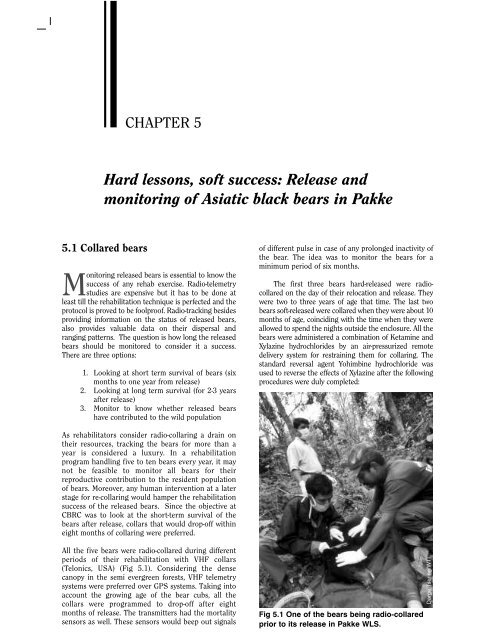Walking The Bears.pdf
Walking The Bears.pdf
Walking The Bears.pdf
- TAGS
- walking
- www.ifaw.org
You also want an ePaper? Increase the reach of your titles
YUMPU automatically turns print PDFs into web optimized ePapers that Google loves.
5.1 Collared bears<br />
CHAPTER 5<br />
Hard lessons, soft success: Release and<br />
monitoring of Asiatic black bears in Pakke<br />
Monitoringreleasedbears is essential to know the<br />
success of any rehab exercise. Radio-telemetry<br />
studies are expensive but it has to be done at<br />
leasttilltherehabilitationtechniqueisperfectedandthe<br />
protocolisprovedtobefoolproof.Radio-trackingbesides<br />
providing information on the status of released bears,<br />
also provides valuable data on their dispersal and<br />
rangingpatterns. <strong>The</strong>questionishowlongthereleased<br />
bears should be monitored to consider it a success.<br />
<strong>The</strong>rearethreeoptions:<br />
1. Looking at short term survival of bears (six<br />
months to one year from release)<br />
2. Looking at long term survival (for 2-3 years<br />
after release)<br />
3. Monitor to know whether released bears<br />
have contributed to the wild population<br />
As rehabilitators consider radio-collaring a drain on<br />
their resources, tracking the bears for more than a<br />
year is considered a luxury. In a rehabilitation<br />
program handling five to ten bears every year, it may<br />
not be feasible to monitor all bears for their<br />
reproductive contribution to the resident population<br />
of bears. Moreover, any human intervention at a later<br />
stage for re-collaring would hamper the rehabilitation<br />
success of the released bears. Since the objective at<br />
CBRC was to look at the short-term survival of the<br />
bears after release, collars that would drop-off within<br />
eight months of collaring were preferred.<br />
All the five bears were radio-collared during different<br />
periods of their rehabilitation with VHF collars<br />
(Telonics, USA) (Fig 5.1). Considering the dense<br />
canopy in the semi evergreen forests, VHF telemetry<br />
systems were preferred over GPS systems. Taking into<br />
account the growing age of the bear cubs, all the<br />
collars were programmed to drop-off after eight<br />
months of release. <strong>The</strong> transmitters had the mortality<br />
sensors as well. <strong>The</strong>se sensors would beep out signals<br />
of different pulse in case of any prolonged inactivity of<br />
the bear. <strong>The</strong> idea was to monitor the bears for a<br />
minimum period of six months.<br />
<strong>The</strong> first three bears hard-released were radiocollared<br />
on the day of their relocation and release. <strong>The</strong>y<br />
were two to three years of age that time. <strong>The</strong> last two<br />
bearssoft-releasedwerecollaredwhentheywereabout10<br />
months of age, coinciding with the time when they were<br />
allowedtospendthenightsoutsidetheenclosure.Allthe<br />
bears were administered a combination of Ketamine and<br />
Xylazine hydrochlorides by an air-pressurized remote<br />
delivery system for restraining them for collaring. <strong>The</strong><br />
standard reversal agent Yohimbine hydrochloride was<br />
used to reverse the effects of Xylazineafter the following<br />
proceduresweredulycompleted:<br />
Fig 5.1 One of the bears being radio-collared<br />
prior to its release in Pakke WLS.<br />
DargeTsering/WTI

















